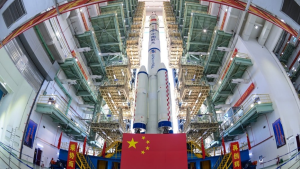A New Technology Turns CO2 into Clothing
On the outskirts of a major industrial hub in Jiangsu, a coastal province of China, a sprawling complex stretches as far as the eye can see. At first glance, it might look like any other manufacturing facility, with its towering smokestacks and maze of pipes. But this is no ordinary factory. Here, in this state-of-the-art complex, something extraordinary is happening: clothes are being made from thin air.
As you approach, you notice a peculiar absence – there are no bales of cotton, no rolls of synthetic fabric. Instead, the process begins with giant fans, their blades slicing through the air, capturing an invisible raw material: carbon dioxide.
Inside this facility of Sheng Hong Holdings Group, an emerging green-tech powerhouse, a series of gleaming reactors hum with activity. They’re not spinning thread or weaving cloth in any traditional sense. Instead, they’re performing a kind of industrial alchemy, transforming the captured CO2 into a clear, viscous liquid – ethylene glycol, a key ingredient in polyester production.
Moving deeper into the complex, you witness the next stage of this miraculous transformation. The glycol is fed into another set of machines, where it’s spun into fine, glistening fibers. These threads, born from the very air we breathe, will soon be woven into fabrics and sewn into garments.
It’s a scene that would have seemed like pure science fiction just a few years ago. Yet here it is, happening on an industrial scale: a technology that turns one of our biggest environmental challenges – excess atmospheric CO2 – into a valuable resource for the fashion industry. Each T-shirt (weigh around 300 grams) produced in this way will use 100 grams of CO2.

As workers in lab coats and hard hats move purposefully through the facility, you can’t help but feel you’re witnessing a revolution. This isn’t just a new way of making clothes; it’s a glimpse into a future where our everyday items could help clean our skies.
Welcome to the cutting edge of eco-fashion, where the clothes of tomorrow are quite literally plucked from thin air. In a bold move towards environmental stewardship and innovation, Sheng Hong Holdings Group has orchestrated a groundbreaking integration of its subsidiary companies to build the world’s pioneering “CO2 capture and utilization – green ethylene glycol – functional polyester fiber” industry chain, epitomized by the eco-chic brand name, Reocoer.
The technology not only captures industrial carbon emissions but transforms them into refined fiber-grade ethylene glycol through a series of chemical reactions. The magic doesn’t stop there. Sheng Hong has further revolutionized the process by developing cutting-edge techniques like direct “esterification-polycondensation” and melt composite spinning. These innovations yield a diverse array of functional polyester fiber products—think elastic, ultra-fine, UV-resistant marvels that have found their place in the textile and apparel realm.
What’s truly captivating about this green revolution is its ripple effect on sustainability within the textile industry. The numbers speak volumes: a staggering 28.4% reduction in carbon emissions compared to traditional fiber production methods. Sheng Hong’s commitment to this environmentally conscious endeavor is evident as they embark on a phased expansion of Reocoer’s carbon capture fiber production capacity. The completion of the first phase signals a remarkable achievement—an annual production capacity of 30,000 tons of recycled polyester fiber.
 The main function of this equipment is to capture and reuse carbon dioxide emissions, converting them into high-quality ethylene glycol.
The main function of this equipment is to capture and reuse carbon dioxide emissions, converting them into high-quality ethylene glycol.
But what truly sets Reocoer apart is its commitment to transparency and quality. Every thread of Reocoer’s carbon capture fiber is traceable, ensuring that the end product not only matches but surpasses the standards set by native fibers. The versatility of these fibers knows no bounds, making them a perfect fit for a wide range of knitted and woven fabrics.
The global textile industry is taking note of this emerging technology. Recently, Reocoer has won the Sustainability & Innovation Award of International Textile Manufacturers Federation. Sheng Hong’s story is a testament to China’s commitment to sustainable development by spearheading a green revolution.
Beyond transforming CO2 into wearable fabrics, China’s textile industry is pushing the boundaries of innovation in other remarkable ways. In Wujiang, for instance, discarded plastic bottles are being repurposed into breathable clothing materials. By breaking down these bottles and subjecting them to various processes, including impurity removal and melting, manufacturers are creating regenerated fibers that can be spun into fabrics. On average, a summer t-shirt can be made from 8 to 10 recycled plastic bottles.
The applications of these new materials extend far beyond the fashion industry. Researchers have developed electrostatic spinning guns capable of producing ultra-fine fibers that can be used to create skin-friendly, water-soluble membranes for medical applications. These membranes have the potential to revolutionize wound care and other areas of healthcare. Furthermore, certain materials have been developed that offer exceptional protective properties. For example, a coating can be applied to eggshells to create a strong, protective layer, preventing them from breaking even when dropped from a significant height. Such materials hold promise for applications in security and anti-explosion technologies.
These innovations highlight China’s growing leadership in sustainable materials science and its commitment to addressing global challenges. As the country continues to invest in research and development, we can expect to see even more groundbreaking advancements in the textile industry, transforming the way we produce and consume clothing and other goods.
Editor: Zhongxiaowen



